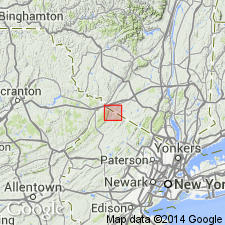
- Usage in publication:
-
- High Point Member*
- Modifications:
-
- Named
- Biostratigraphic dating
- Dominant lithology:
-
- Graywacke
- Shale
- AAPG geologic province:
-
- Appalachian basin
Summary:
The High Point Member of the Martinsburg Formation is here named in northern NJ and southeastern NY. Consists of thick graywacke beds resulting from sedimentary amalgamation with interbeds of dark-colored shale. Graywacke has siliceous cement, rip-up clasts of shale, and abundant load casts. Assigned to turbidite facies B and C and was deposited in a much higher energy environment than the other parts of the Martinsburg. Overlies the Ramseyburg Member of the Martinsburg in an unknown manner, probably gradationally. Rocks similar to the High point, called the informal graywacke at Pine Bush (Epstein and Lyttle, 1987), are interbedded with rocks resembling the Ramseyburg in the Pine Bush quad., NY. Unconformably underlies the Shawangunk Formation. Thickness is as much as 4,500 ft in the Unionville quad. Age of the upper part at least is Late Ordovician (Edenian, Caradocian) based on graptolites.
Source: GNU records (USGS DDS-6; Reston GNULEX).
For more information, please contact Nancy Stamm, Geologic Names Committee Secretary.
Asterisk (*) indicates published by U.S. Geological Survey authors.
"No current usage" (†) implies that a name has been abandoned or has fallen into disuse. Former usage and, if known, replacement name given in parentheses ( ).
Slash (/) indicates name conflicts with nomenclatural guidelines (CSN, 1933; ACSN, 1961, 1970; NACSN, 1983, 2005, 2021). May be explained within brackets ([ ]).

